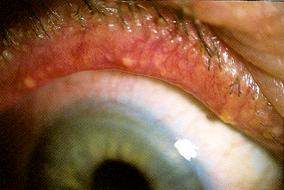|
Ocular Rosacea
Rosacea is a dermatologic condition that affects
the nose, cheeks, forehead, chin, and glabella
(the area between the eyes and above the nose).
More than 50% of patients with rosacea have
ocular manifestations.
Ocular rosacea manifestations are essentially
confined to the eyelids and ocular surface.
Problems range from minor irritation, dryness,
and blurry vision to potentially severe ocular
surface disruption and inflammatory keratitis.
Blepharitis and conjunctivitis are the most
common findings in patients with ocular rosacea |
|
 |
|
Other ocular findings include
lid margin and conjunctival telangiectasias
(curly-cue blood vessels), eyelid crusting and
scales, punctuate epithelial erosions, corneal
infiltrates, corneal ulcers, and vascularization.
Sight-threatening disease is rare with rosacea;
however, keratitis can result in sterile corneal
ulceration and eventual perforation if not
treated aggressively.
The symptoms of rosacea can be treated
effectively. Since rosacea is a chronic
condition with exacerbations and remissions,
long-term therapy to maintain symptomatic
control is required.
Ocular rosacea is a syndrome of unknown cause.
It is commonly misdiagnosed or undiagnosed. It
usually has no previous family or personal
history. It occurs at the greatest frequency in
the 30- to 70- year age range, but may also be
found in pediatric patients. Women are affected
with rosacea twice as often as men. More than
10% of the general population exhibits
dermatologic characteristics of rosacea; of
these, up to 60% experience ocular
complications. Approximately 5% of patients with
rosacea manifest corneal disease, which may be
severe and can lead to blindness via corneal
ulceration, secondary infections, or corneal
opacification from vascularization.
Usually, there exists a history of recurrent lid
problems such as “styes”, chalazia, hordeoli,
and chronic marginal blepharitis. Symptoms are
usually synonymous with the level of involvement
and associated complications. This is not
contagious!
Treatment consists of daily lid hygiene. Hot
compresses applied to the eyelid margins can
help to liquefy the thick meibomian gland
secretions and, thus, facilitate their
expression. Mild, nonirritating cleaning
solutions, such as diluted baby shampoo or
commercially prepared eyelid scrubs, can be
applied to the eyelids to remove clogging
debris. Additionally, light pressure applied to
the eyelids can aid in gland expression.
Preservative free artificial tears should be
used liberally throughout the day and, if
necessary, a lubricating ointment may be used at
night. Antibiotics may prove to be useful. Oral
medications such as tetracycline, erythromycin,
and topical skin creams such as metronidazole
may be considered under doctor’s supervision.
Topically, steroid drops have been proven
helpful to reduce inflammation. Recently, newer
topical drop therapy using AzaSite, Blephamide,
Tobradex and Restasis may be used concurrently
to create a greater effect. |